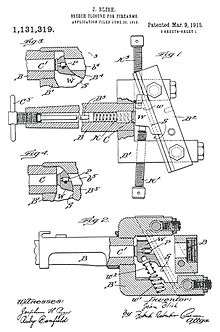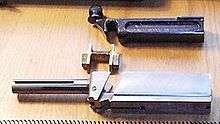Blish lock
The Blish lock is a breech locking mechanism designed by John Bell Blish based upon his assumption that under extreme pressures, certain dissimilar metals would resist movement with a force greater than friction laws would predict. In modern engineering terminology, it is an extreme manifestation of what is now called static friction, or stiction. His locking mechanism was used first in the Thompson submachine gun. Nowadays it is discredited as an useful firearm operating principle, due to its almost nonexistent effects on the operation and functioning of a firearm; because of that, firearms which theoretically employed it operate not by the supposed Blish lock principle, but, in fact, by blowback operation.


Invention
The Blish lock resulted from John Blish's observation of large naval guns. He noticed that the breech blocks of naval guns with interrupted thread breeches remained closed when fired with full charges, but tended to unscrew when fired with light charges. He concluded that dissimilar metals have a tendency to adhere to each other when subjected to very high pressure. This principle of metallic adhesion of dissimilar metals became known as the Blish principle. Blish put this theory to use in a delayed-blowback breech mechanism. He developed a working model that used a simple wedge as the delay mechanism, and was eventually assigned U.S. Patent 1,131,319 on March 9, 1915. Despite the patent and production of the system on the Thompson submachine gun, the Blish principle found no scientific proof.[1] The Blish locking block was removed from the gun without substantial change to its function.
Applications
The most famous application of the Blish lock was Thompson submachine gun, also the Thompson Autorifle. Several engineers suspected the autorifle functioned more as a delayed blowback than as an adhesion-locked breech action.[2] Some authorities, such as Julian Hatcher, felt the Blish lock as employed in the submachine gun did not accomplish much in terms of actual breech locking. In fact, the submachine gun was successfully redesigned as a simple blowback weapon (the M1/M1A1). Any real advantages to the system were far outweighed by the additional cost of manufacture associated with the device. Also, in the Thompson submachine gun the H-shaped bronze lock connects the bolt actuator to the bolt body; incorrect installation of the Blish lock can render a Thompson inoperable upon firing.
References
- Matthew Moss. "The Tale of the Tommy Gun", Popular mechanics Feb 27, 2017
- Julian S. Hatcher, Hatcher's Notebook, Military Service Publishing Co., 1947, pages 44-46.